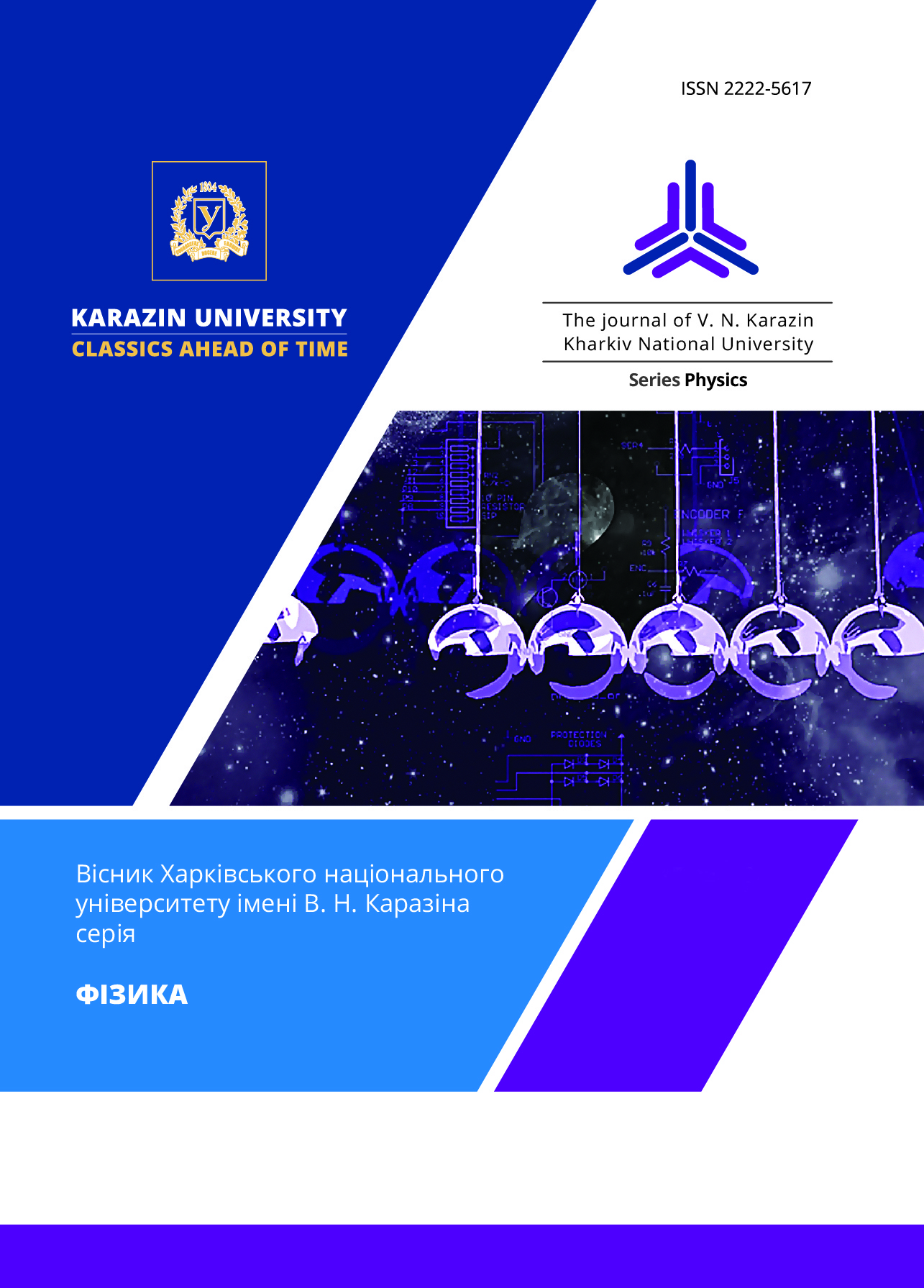Композиційні сцинтилятори на основі мікропорошків ZnWO4:Me+, отриманих методом твердофазного синтезу
Анотація
У роботі розглянуто можливість поліпшення функціональних характеристик (світлового виходу та рівня післясвічення)
композиційних сцинтиляторів на основі синтезованого за твердофазною реакцією мікропорошку ZnWO4 методом
гетеровалентного легування. До суміші вихідних оксидів ZnO та WO3 додавали LiNO3, Li2SO4, Cs2SO4, Rb2SO4 у кількості 0,003
мас. %. Синтез проводили на повітрі за 950 °С протягом 30 годин. Дослідження морфології одержаних порошків проводили
методом скануючої електронної мікроскопії (СЕМ ). Показано, що на розмір зерен синтезованих порошків більшою мірою
впливає розмір катіона, який заміщує Zn2+, ніж наявність мінералізатору з низькою температурою плавлення. Досліджені
аніони не впливають на процес синтезу: так при додаванні ZnSO4 розмір одержаних зерен подібний до номінально чистого
синтезованого ZnWO4. При легуванні Li+, який є меншим від Zn2+ на 20%, не залежно від аніонної складової, середній розмір
зерна збільшується у 4 рази. При легуванні Rb+ та Cs+, які майже вдвічі більше від Zn2+, спостерігається зростання зерен у
20 разів, що говорить про значне розпушення кристалічної ґратки утвореними нульмерними дефектами, що сприяє кращій
дифузії реагентів та прискоренню процесу синтезу. Дослідження рентгенолюмінесценції показало подібність спектрів
синтезованих порошків ZnWO4:Me+ до спектру монокристала ZnWO4, що відповідає свіченню автолокалізованого екситона на
оксіаніонном комплексі WO6
6-. Інтенсивність полос зростає відповідно до збільшення катіонного радіусу легуючої домішки:
Li+ → Rb+ → Cs+. Максимальна інтенсивність рентгенолюминесценції спостерігається для мікропорошку ZnWO4:Cs+, яка
вдвічі перевищує інтенсивність нелегованого мікропорошка ZnWO4. Це обумовлюється достатньо високим ступенем
деформації структури центру свічення WO6
6-, впливаючи тим самим на люмінесцентні властивості матеріалу. Композиційні
зразки на основі синтезованих порошків виготовляли з використанням в якості зв’язуючого оптичного синтетичного
каучуку СКТН в кількості 50 мас.%. Результати вимірювання відносного світлового виходу композиційних сцинтиляторів
на основі ZnWO4:Me+ корелюють з результатами вимірювань інтенсивності рентгенолюмінесценції синтезованих порошків
і зростають зі збільшенням радіуса легуючого катіона. Вимірювання рівня післясвічення показало, що застосування методу
гетеровалентного легування, а саме Me+, є дієвим шляхом покращення сцинтиляційних параметрів кристалічних матеріалів.
Композиційні сцинтилятори на основі ZnWO4:Cs+ та ZnWO4:Rb+ демонструють значення світлового виходу та післясвічення
на рівні композиту з розмеленого монокристалу ZnWO4, та не гірше монокристалічного зразка ZnWO4. Отримані матеріали є
перспективними для застосування в сцинтиляційних детекторах комп’ютерної томографії та пристроїв цифрової радіографії.
Ключові слова: ZnWO4, ZnWO4:Ме+, світловий вихід, післясвічення, композиційний сцинтилятор, синтез ZnWO4,
рентгенолюмінесценція ZnWO4.
Завантаження
Посилання
2. H. Grassman. J. Lumin., 33, 109 (1895)
3. S.E. Derenzo, W.W. Moses Experimental efforts and results
in finding new heavy scintillators. Heavy Scintillators for
Scientific and Industrial Applications, Editions Frontières,
Gif-sur-Yvette (1993), p. 125
4. S.E. Derenzo. IEEE Nucl. Sci. Symp. Conf. Record, 1, 143
(1991)
5. M. Ishi, M. Kobayashi. Prog. Cryst. Growth Charact., 23,
245 (1991)
6. М. Moszynski, М. Kapusta, D. Wolski. IEEE Trans. Nucl.
Sci. 45(3), 472, 7 (1998)
7. K. Takagi. J. Cryst. Growth (1981)
8. P. Belli. Nucl. Instrum. Methods A, 935, 89 (2019), https://
doi.org/10.1016/j.nima.2019.05.014
9. P. Belli. Nucl. Instrum. Methods A, 626, 31 (2011), https://
doi.org/10.1016/j.nima.2010.10.027
10. Y.C. Zhu. nucl. instr. and Meth. A, 244, 3, 579 (1986)
11. D. spassky. Opt. Mater. 36, 10, 1660 (2013), https://doi.
org/10.1016/j.jlumin.2013.06.039
12. n.R. Krutyak. J. Lumin. 144, 105 (2013), https://doi.
org/10.1016/j.jlumin.2013.08.042
13. V. nagirnyi. Radiat. Eff. Defects solids, 52, 16 (2002),
https://doi.org/10.1016/s0168-9002(02)00740-4
14. H. Kraus. Phys. stat. sol., A 204, 730 (2007), https://doi.
org/10.1002/pssa.200622331
15. F.A. Danevich. Phys. stat. sol., A 205, 335 (2008)
16. L.L. nagornaya. iEEE Trans. nucl. sci., ns-55, 1469
(2008), https://doi.org/10.1109/tns.2007.910974
17. м. Gandini.nat. nanotech., 18,17 (2020), https://doi.
org/10.1038/s41565-020-0683-8
18. K.J. Wilson. scientific Reports., 29, 10, 115 (2020), https://
doi.org/10.1038/s41598-020-58208-y
19. R. Abolhasan. scientific Reports. 17, 80, 167 (2018), https://
doi.org/10.1353/isl.2018.0010
20. E.A. McKigney. nucl. instrum. Metho Rdes.s . PВh: ys.
579(1), 15 (200h7t)t,p s://doi.org/10.1016/j.
nima.2007.04.004
21. P. Büchele. nat. Photonics. 12, 838 (2015), https://doi.
org/10.1038/nphoton.2015.216
22. Ya. Gerasymov. Opt. Mater. 109,110305 (2020), https://doi.
org/10.1016/j.optmat.2020.110305
23. Q. Li. Opt. Mater. 102, 109805(2020), https://doi.
org/10.1016/j.optmat.2020.109805
24. T.C. Wu. nucl. instrum. Methods. Phys. Res. B nUCL
insTRUM METH A: 101(6), 42 (2020), https://doi.
org/10.1016/j.nima.2020.164265
25. A.Yu. Boyarintsev. Methods. Phys. Res. B nUCL insTRUM
METH A: 1, 982, 164583 (2020), https://doi.org/10.1016/j.
nima.2020.164583
26. Yu. Boyarintsev. nucl. instrum. Methods. Phys. Res. B. 21,
930, 180 (2019), https://doi.org/10.1016/j.nima.2019.03.100
27. V. Govindan. J. Cryst. Growth. 1, 531, 125344 (2020),
https://doi.org/10.1016/j.jcrysgro.2019.125344
28. B.W. Wiggins. Methods. Phys. Res. B nUCL insTRUM
METH A: 915, 17, 23 (2019), https://doi.org/10.1016/j.
nima.2018.10.165
29. В.Д. Рижиков, № a 2014 12679, д. з.: 25.11.2014, д. публ.
25.08.2015
30. V. Litichevskyi. Func. мater. 2, 126, 203 (2011), https://doi.
org/10.15407/scin12.06.039
31. V.D. Ryzhikov. Func. мater. 25, 1, 172 (2018), https://doi.
org/10.15407/fm25.01.172
32. V.s. Tinkova. Tech. Konstr. ektr. Appar.: Materials
of electronics. 1,2, 40 (2019)
33. L.L. nagornaya. iEEE Trans nucl sci. 55, 3, 1469 (2008),
https://doi.org/10.1109/tns.2007.910974
34. Watterich. solid state Commun. 88, 8, 619 (1993), https://
doi.org/10.1016/0038-1098(93)90063-s
35. R. Dafinova. J. Lumin. 75, 51 (1997), https://doi.org/10.1016/
s0022-2313(97)00105-1
36. H. Kraus. Phys. Stat. Sol. 204, 3, 730 (2007), https://doi.
org/10.1016/j.nima.2006.10.099
37. H.D. Jenkins. J. Chem. Educ. 56, 576 (1979)
38. P Lorchirachoonkul. J.Lumin. 207, 333 (2019), https://doi.
org/10.1016/j.jlumin.2018.11.025
39. P. Lorchirachoonkul. J.Lumin. 197, 131 (2018), https://doi.
org/10.1016/j.jlumin.2018.01.018
40. L. Li. J.Lumin. 117, 16, 377 (2020), https://doi.org/10.23947/
interagro.2020.1.318-322
41. M. Pawlikowska M. Ceram. Int. 1, 3, 14135 (2017), https://
doi.org/10.1016/j.ceramint.2017.07.154
42. G. Huang. Mater. Sci. Eng.: B. 139, 2, 20 (2007), https://doi.
org/10.1016/j.mseb.2007.02.009
43. G.B. Kumar. Ceram. Int.1, 36, 199 (2010), https://doi.
org/10.1016/j.ceramint.2009.07.005
44. В. П. Глушко. Термические константы веществ:
Справочник, ВИНИТИ АН СССР, М. (1982), 368 c.
45. Р. А. Лидин. Справочник по неорганической химии,
Химия, М. (1987), 320 с.
46. Г. А. Бабич. Полярографические исследования
восстановительной способности нестехиометрического
оксида вольфрама (VI), РМ Ф, М. (1994), 317 с.
47. A.E. Ovechkin. Phys. Status Solidi A, 16, 103, 285 (1987),
https://doi.org/10.1002/pssa.2211030133
48. I.A. Tupitsyna. Func.Mater. 23, 4, 535 (2016), https://doi.
org/10.15407/fm23.04.357
49. B. Ding. Sci. Rep. 5, 1, 43 (2015), https://doi.org/10.1038/
srep09443
50. Magrasó. J. Mater. Chem. A. 2, 32, 12630 (2014), https://doi.
org/10.1039/c4ta00546e
51. P. F. S. Pereira. Phys. Chem. Chem. Phys. 20, 3, 1923 (2018),
https://doi.org/10.1039/c7cp07354b








3.gif)
